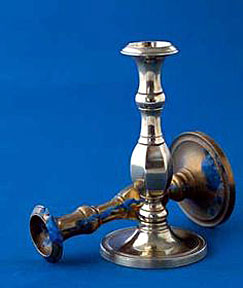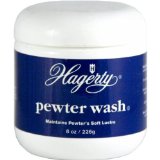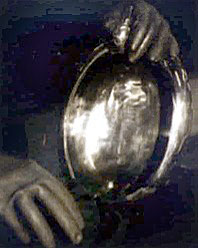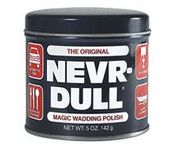Caring for Pewter
by
Bob Brooke
 Most collectors are more concerned with the
appearance of their pewter pieces, making cleaning and polishing a must.
This you can do if your patience and arm hold out. If you plan on doing
your own cleaning, then you should practice on more modern pieces. Most collectors are more concerned with the
appearance of their pewter pieces, making cleaning and polishing a must.
This you can do if your patience and arm hold out. If you plan on doing
your own cleaning, then you should practice on more modern pieces.
If you acquire an earlier and rarer piece, you should entrust its repair
and reconditioning to an expert. When it comes back, you can examine it
closely to see how well the work was done, and this will give you a
standard for your own efforts.
In starting to clean and polish a piece of pewter, hold it to the light
and examine it for any fine holes. If it’s a tankard, teapot or other
hollow piece, fill it with water to test for leaking seams or joints.
You can repair these by using a small soldering iron and plumber’s
solder. You should also practice to learn how to use the least possible
amount of solder to close a hole or sealing a seam.
 After cleaning your pewter pieces, you’ll need to polish them. Unless a
piece has become badly oxidized, the dull slate-gray surface of a long
neglected piece will yield to patient rubbing with a mild abrasive. An
ordinary kitchen scouring powder, moistened with a little kerosene,
works well. With stubborn pieces, try powdered Bristol brick, standard
for scouring steel knives. If this doesn't produce desired results, try
the fine grade of emery paper, and then 4-zero (0000) steel wool. With
either, use kerosene instead of water. It brings out the desired sheen
more readily. Even using this procedure, you may find some stubborn
spots that you’ll have to rub with a piece of fine emery cloth. This
should be done sparingly or you’ll cut too deep into the metal. Such
cleaning and polishing must be followed by thoroughly washing with soap
and hot water to rid the pewter of all traces of oil. After cleaning your pewter pieces, you’ll need to polish them. Unless a
piece has become badly oxidized, the dull slate-gray surface of a long
neglected piece will yield to patient rubbing with a mild abrasive. An
ordinary kitchen scouring powder, moistened with a little kerosene,
works well. With stubborn pieces, try powdered Bristol brick, standard
for scouring steel knives. If this doesn't produce desired results, try
the fine grade of emery paper, and then 4-zero (0000) steel wool. With
either, use kerosene instead of water. It brings out the desired sheen
more readily. Even using this procedure, you may find some stubborn
spots that you’ll have to rub with a piece of fine emery cloth. This
should be done sparingly or you’ll cut too deep into the metal. Such
cleaning and polishing must be followed by thoroughly washing with soap
and hot water to rid the pewter of all traces of oil.
Some pieces that will not come bright under this treatment because the
oxidation is deep-seated may yield to sterner methods. Try soaking such
a piece in a penetrating oil used at garages to loosen rust-frozen
bolts. While still covered with the oil, scrub the piece with a piece of
wood. If scales still cling to the surface, add a little nitric acid and
scrub again.
 If this also fails, the last resort is boiling in lye; but in using this
remember that lye is a strong caustic and can cause a serious burn. Wear
goggles to protect your eyes from a chance spatter, as well as
oil-treated leather work gloves for the safety of your hands. Have a
pair of kitchen tongs at hand so you can remove the piece for
examination. Since the fumes of boiling lye are disagreeable, open a
window and have a bottle of vinegar at hand as a counteragent if the lye
should spatter. If this also fails, the last resort is boiling in lye; but in using this
remember that lye is a strong caustic and can cause a serious burn. Wear
goggles to protect your eyes from a chance spatter, as well as
oil-treated leather work gloves for the safety of your hands. Have a
pair of kitchen tongs at hand so you can remove the piece for
examination. Since the fumes of boiling lye are disagreeable, open a
window and have a bottle of vinegar at hand as a counteragent if the lye
should spatter.
Do this boiling in an old iron, brass or enamel-ware kettle, never in
one of aluminum, for the lye will eat through that metal. Do not use too
strong a solution; a half-cup of lye to a quart of water is strong
enough. Watch the boiling carefully. Boiling too long can ruin a piece
of pewter, so remove the piece frequently for examination and stop the
process before the caustic action has gone beneath the surface.
After treating the pewter, you should thoroughly rinse or even soak in
clear water to remove all trace of the lye. Now you’re ready to polish
it.
 Once a collection of pewter has been cleaned and polished, the problem
is how to keep it bright and shining. If the pieces are used on the
dining table fairly regularly, ordinary washing with soap and water,
together with occasional polishing with any good silver polish, will be
sufficient. With pieces used infrequently, the best practice is to
polish them about twice a month. Rubbing them with a woolen cloth
dampened with a light oil will be sufficient. In order not to leave
fingerprints that cause tarnish, wear a pair of latex gloves when doing
this polishing. Once a collection of pewter has been cleaned and polished, the problem
is how to keep it bright and shining. If the pieces are used on the
dining table fairly regularly, ordinary washing with soap and water,
together with occasional polishing with any good silver polish, will be
sufficient. With pieces used infrequently, the best practice is to
polish them about twice a month. Rubbing them with a woolen cloth
dampened with a light oil will be sufficient. In order not to leave
fingerprints that cause tarnish, wear a pair of latex gloves when doing
this polishing.
For more information
on cleaning and polishing pewter,
click here.
To read
more of my articles, please
visit
my Web site.
<
Back to Caring for Your Collections
Archives
Next Article >
|
